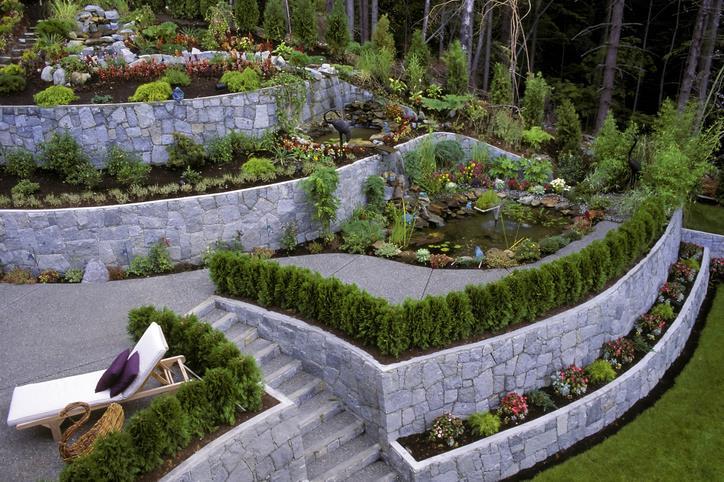Landscape project planning encompasses processes outside of production in the construction sector. It involves beautifying, planning, and designing spaces or living areas, from the smallest to the largest scale, with an emphasis on aesthetic appearance and ecological integration within certain rules. It includes the planning, design, and implementation of open and green spaces in planned areas, as well as atriums and rooftop areas. It also covers areas within municipal boundaries. Additionally, the expertise of landscape architects extends to the planning and design of conservation areas, sports and entertainment complexes, tourism areas, and open areas along rivers and lakeshores.
To enhance the aesthetic appeal of living spaces, proper planning of garden landscaping is essential. Volumes and surfaces should be approached within the framework of scientific principles during planning and design. Issues related to the implementation area should be examined and identified. Subsequently, solutions should be planned by evaluating aesthetic, functional, ecological, and economic conditions as a whole.
Demah Design Landscape Project Drawing and Consultancy Services
With the awareness that every project is based on the principle of bringing together different elements in a balanced and homogeneous whole, we aim to achieve maximum efficiency with our artistic architectural team in our landscape projects by completing our design process stages with a systematic working program. While aiming for results that evoke visual and sensory appreciation, we attach importance to maintaining our applications in a balanced composition, ensuring their continuity, and making them sustainable.
- Garden landscaping is an essential part of our work.
- In addition to gardens, we also provide solutions for beaches, pool surroundings, parks, residential complexes, walking paths, river and lake shores.
- We plan pleasant and comfortable areas suitable for use in sports and entertainment complexes, modern facilities, and social facilities.
We visualize our planning and design process for our clients. We present our solutions before implementation visually with 3D Modeling. It is important for us that the landscape project designs we create are feasible results.
While beautifying outdoor spaces with solutions suitable for every budget, we take into account the growth rates of the plants we plan in our garden arrangements in the following years. From lighting equipment to irrigation systems, we offer implementable solutions down to the smallest detail.
In our landscape project drawings, our goal is not only to give outdoor areas a visual appearance but also to create comfortable spaces by establishing connections with environmental and cultural conditions. In our garden arrangements, while adding visual appeal, we also aim to create peaceful and comfortable living spaces.
We give importance to creating an identity and character by paying attention to the aesthetic appearance and ecological design of areas outside buildings in living spaces. We believe in the necessity of creating a functional and dynamic environment. We plan with the belief that the concept of integrity is important in all areas within and outside the boundaries of the implementation area, aiming to give landscape and environmental arrangements holistic beauty.
Understanding the natural, cultural, and environmental aspects is crucial for the organization and sustainability of green spaces. Therefore, we conduct detailed examinations during the problem recognition phase related to the implementation area.
In addition to beautifying living spaces with green areas, irrigation is crucial for their sustainability. We carefully plan irrigation areas to ensure effective and accurate results after the project designs are implemented.
In our landscape planning, we pay attention to every stage of the design process to ensure successful and effective results for all our applications, from the smallest to the largest scale. With a professional team, we create a rational roadmap in the planning and design process.
For information about all our landscape project services, from small to large-scale, micro, and macro-scale, please contact us.

Landscape Design Process Stages
- Defining the boundaries of the project area
- Defining and identifying the areas to be addressed within the existing boundaries
- Gathering information and data on all conditions and characteristics within and outside the implementation area
- Problem definition and evaluation of collected information and data
- Conscious and effective management planning based on evaluations
- Planning with aesthetic, scientific, engineering, and economic solutions that will maximize efficiency in line with architectural standards
- Implementation stages of visually and sensually appealing spaces after solution-oriented planning and design phases.
Success of Landscape Project Design Applications
One of the most effective elements in the success of landscape projects is the individual's ability to prioritize the concept of integrity and perceive, describe, and define natural, cultural, and environmental aspects within the framework of architectural and engineering principles. Depending on whether the implementation area is individual or public, they should be able to evaluate science, art, technology, mathematics, geomorphology, soil, ecology, and botany as a whole. They should have an aesthetic view and prioritize the cultural infrastructure of the implementation area, as well as the ability to think creatively and three-dimensionally. Proficiency in using architectural-related computer programs is also necessary.
Symmetry is one of the most important criteria for creating a beautiful visual appearance.
It should not be forgotten that buildings and open spaces complement each other and add value together. The design process, where the concept of integrity is emphasized, is one of the most important elements of implementation success. Emphasis should be placed on achieving aesthetic balance and harmony. Green and architectural elements should be selected and positioned in harmony with each other to create visual appeal.
The feasibility and sustainability of what is planned and designed for the project area after implementation are crucial criteria for success. It is essential that each stage of the design process is completed comprehensively. From the first stage, each stage of the process must be completed thoroughly before moving on to the next stage. Proper completion of one stage is the basis for the successful completion and shaping of the next stage.
The results of the implementation should create a quality and usable environment while also ensuring its preservation and sustainability.